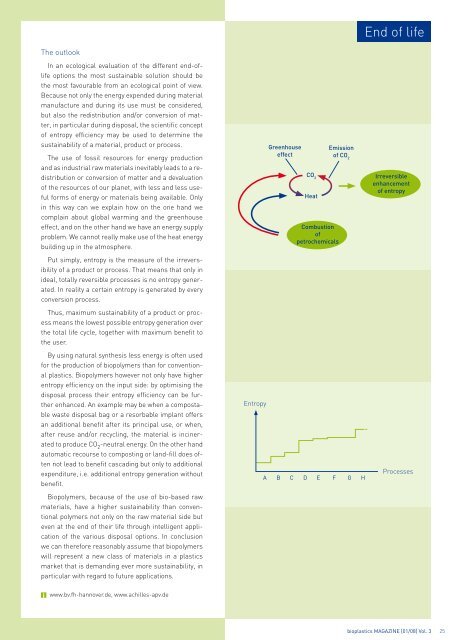01 | 2008
Create successful ePaper yourself
Turn your PDF publications into a flip-book with our unique Google optimized e-Paper software.
End of life<br />
The outlook<br />
In an ecological evaluation of the different end-oflife<br />
options the most sustainable solution should be<br />
the most favourable from an ecological point of view.<br />
Because not only the energy expended during material<br />
manufacture and during its use must be considered,<br />
but also the redistribution and/or conversion of matter,<br />
in particular during disposal, the scientific concept<br />
of entropy efficiency may be used to determine the<br />
sustainability of a material, product or process.<br />
The use of fossil resources for energy production<br />
and as industrial raw materials inevitably leads to a redistribution<br />
or conversion of matter and a devaluation<br />
of the resources of our planet, with less and less useful<br />
forms of energy or materials being available. Only<br />
in this way can we explain how on the one hand we<br />
complain about global warming and the greenhouse<br />
effect, and on the other hand we have an energy supply<br />
problem. We cannot really make use of the heat energy<br />
building up in the atmosphere.<br />
Put simply, entropy is the measure of the irreversibility<br />
of a product or process. That means that only in<br />
ideal, totally reversible processes is no entropy generated.<br />
In reality a certain entropy is generated by every<br />
conversion process.<br />
Thus, maximum sustainability of a product or process<br />
means the lowest possible entropy generation over<br />
the total life cycle, together with maximum benefit to<br />
the user.<br />
By using natural synthesis less energy is often used<br />
for the production of biopolymers than for conventional<br />
plastics. Biopolymers however not only have higher<br />
entropy efficiency on the input side: by optimising the<br />
disposal process their entropy efficiency can be further<br />
enhanced. An example may be when a compostable<br />
waste disposal bag or a resorbable implant offers<br />
an additional benefit after its principal use, or when,<br />
after reuse and/or recycling, the material is incinerated<br />
to produce CO 2 -neutral energy. On the other hand<br />
automatic recourse to composting or land-fill does often<br />
not lead to benefit cascading but only to additional<br />
expenditure, i.e. additional entropy generation without<br />
benefit.<br />
Biopolymers, because of the use of bio-based raw<br />
materials, have a higher sustainability than conventional<br />
polymers not only on the raw material side but<br />
even at the end of their life through intelligent application<br />
of the various disposal options. In conclusion<br />
we can therefore reasonably assume that biopolymers<br />
will represent a new class of materials in a plastics<br />
market that is demanding ever more sustainability, in<br />
particular with regard to future applications.<br />
Entropy<br />
Greenhouse<br />
effect<br />
CO 2<br />
Heat<br />
Combustion<br />
of<br />
petrochemicals<br />
Emission<br />
of CO 2<br />
A B C D E F G H<br />
Irreversible<br />
enhancement<br />
of entropy<br />
Processes<br />
www.bv.fh-hannover.de, www.achilles-apv.de<br />
bioplastics MAGAZINE [<strong>01</strong>/08] Vol. 3 25


















